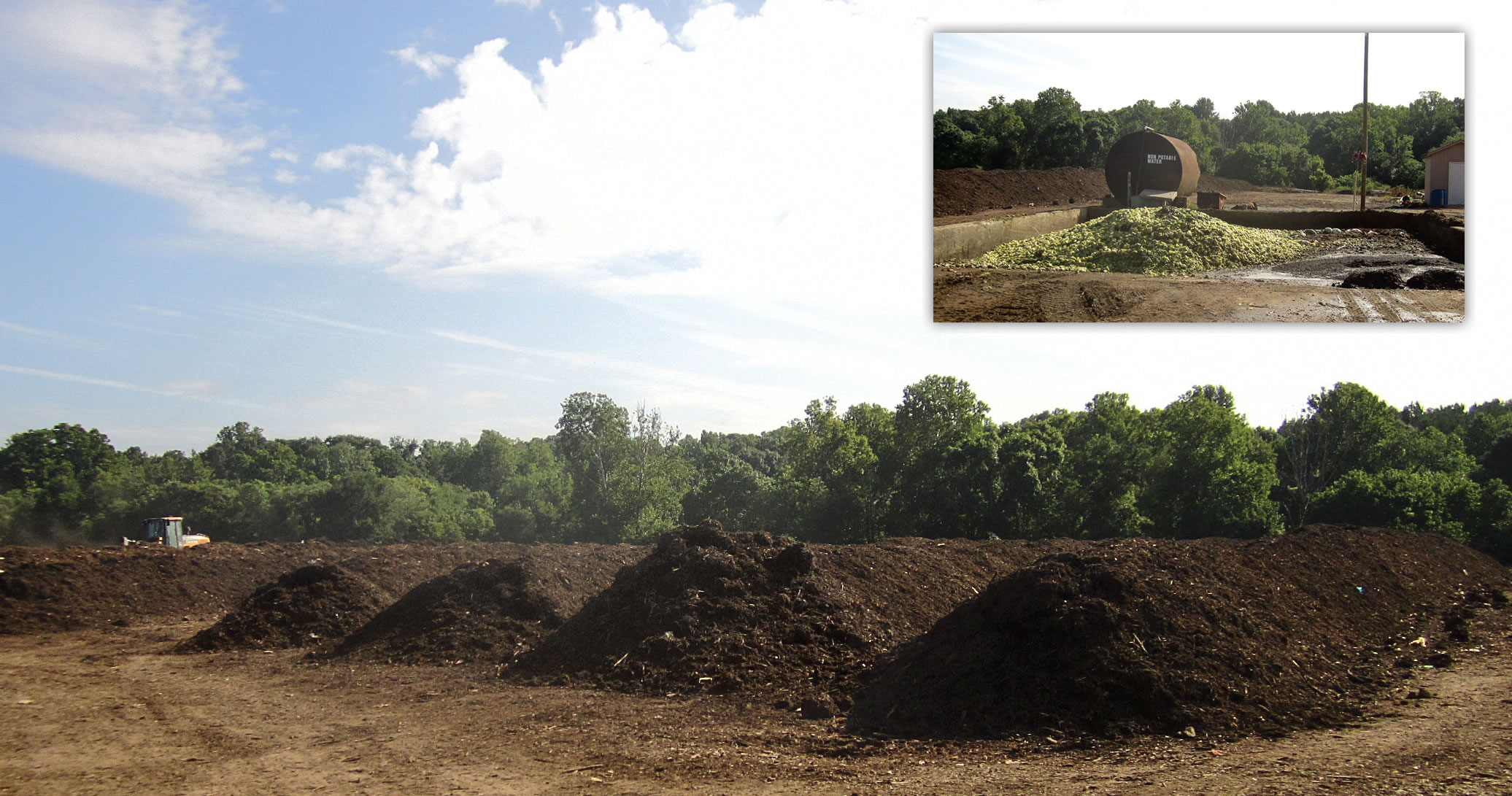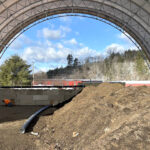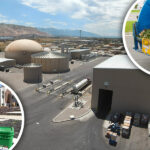The basic components of a robust food recovery and recycling infrastructure are emerging in North Carolina. The next step is scaling up.
Jorge Montezuma and Scott Mouw
BioCycle October 2015
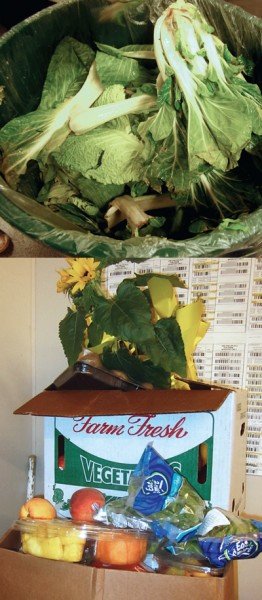
Food Lion is implementing food recovery at its stores statewide with a high priority on rescue and donation.
In 2012, the North Carolina Department of Environment and Natural Resources (NC DENR) helped to coordinate the first ever Southeastern Food Waste Reduction Conference. The event was intended to create momentum in addressing a very large but relatively unrecovered waste stream. An NC DENR study that same year documented that the Tar Heel state generated more than 1.2 million tons of food waste annually, split roughly evenly between residential and commercial material. Although progress was being made in diverting some commercial food waste, there was clearly still a long road to go.
This year, NC DENR is once again helping support an event designed to accelerate food waste reduction and diversion with the Food Recovery Summit (Summit) in Charleston, South Carolina, November 16–18 (see box). In the three years since the last conference, interest and activity around food recovery has grown in North Carolina. From fledgling initiatives on residential food waste to an expanding composting infrastructure and impressive progress by supermarkets, food recovery is gaining steam.
In addition to a strong network of food banks, food rescue organizations are growing in many of the state’s urban areas. An excellent example is Inter-Faith Food Shuttle (IFFS) in Raleigh, which operates collection routes serving an array of restaurants, cafeterias and other sources of leftover, edible food throughout seven counties. IFFS, which will be featured at the Summit, also supplements its rescue operations with culinary job training and teaching farms, bringing fresh local food into its hunger relief operations at local soup kitchens and children’s programs.
Processing Capacity
Because not all generated excess food is suitable for feeding people, North Carolina is increasingly relying on development of a commercial composting infrastructure to divert more material. The state’s two largest urban areas are fairly well served by relatively large commercial composters, including McGill Environmental and Brooks Contractors in the Raleigh-Durham area, and Wallace Farms and Earth Farms in the Charlotte area. Brooks Contractors and Earth Farms also operate collection services to source food waste from a variety of commercial, industrial and institutional sources. Smaller scale composters with embedded collection services are expanding diversion opportunities into additional markets, such as Danny’s Dumpster in Asheville and Gallins Farms near Winston-Salem.
Entrepreneurial interest in food waste composting remains high and it is starting to have an effect. In 2014, the latest year of state reporting, composters received approximately 31,500 tons of food waste, up ten percent from the previous year. With new food waste-oriented collection services such as SMART Recycling and Food FWD growing their operations, the business of food recovery is gaining momentum.
Anaerobic digestion (AD) is also getting a foothold. The farm-based Full Circle operation in Zebulon, just east of Raleigh, is actively seeking commercial and industrial food waste to add to its hog manure digester. BlueSphere, with power purchase agreements in place, is constructing a large AD facility in Charlotte and looking to source a wide variety of organic streams, including food waste. Together, these digesters have about 565 tons/day of permitted capacity. Combined with the commercial composters, these facilities have a collective appetite for food waste feedstocks that well exceed the amount currently being collected. Successful large-scale use of animal feeding options is also far from meeting its material demand potential.
Overall, underutilized and expandable end use infrastructure in North Carolina (which would also include the many food rescue and donation operations) is a strong signal that more collection is needed. And if that collection system can be built in a smart way, it will provide for increasingly dense and efficient routing over time.
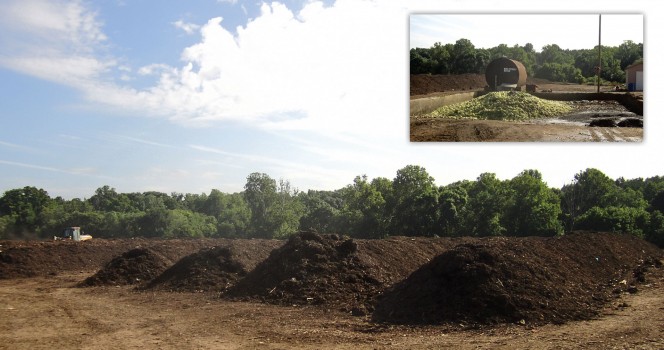
In addition to operating a composting facility, Earth Farms, located near Charlotte, offers food waste collection services (fresh load on receiving pad, inset).
Increasing Diversion
A number of promising developments show that collection, which is highly dependent on generator commitment to diversion, is expanding. Supermarkets such as Publix that are expanding into the state arrive with a standing corporate commitment to food diversion. Their utilization of food waste service providers, such as Earth Farms, is helping grow those businesses, providing an anchor for food recovery in key markets. Food Lion, a company in the DelHaize group, is also implementing food recovery at its stores statewide with a comprehensive approach that places a high priority on rescue and donation. With others such as Whole Foods, Walmart, and Kroger also on board, North Carolina is not far from seeing all of its major supermarket chains permanently committed to food recovery, a fundamental shift in this critical sector in just a few short years.
Institutional sources of food waste are not far behind, however, and growing quickly. Many of the state’s major public and private universities have been actively collecting and composting food waste on-site or off-site for a number of years. As one example, Appalachian State runs a highly successful forced air on-site system at its campus in Boone, providing the university with a key pillar to reach its zero waste to landfill goal. The K-12 schools in Buncombe, Orange, Mecklenburg and Wake counties are also now diverting cafeteria food wastes, with additional interest growing in other school systems in the state.
Active local governments have fostered such programs in Orange and Mecklenburg counties. Orange was well ahead of its peers as the first community to commit staff and budget resources to creating commercial food waste routes (which in turn helped build private collection and composting services that now are available to adjoining communities). More recently, Mecklenburg County has been a key partner in implementation of a project spearheaded by the Sustainable Packaging Coalition to increase interest in food collection in the greater Charlotte area. The recently completed project received funding from U.S. EPA Region 4, which has been proactive in helping develop food waste initiatives in a number of southeastern states. (See summary of the project in “BioCycle World” in this issue.)
Lagging behind is capture of residential food waste. To date, no local government has tried collection from single-family homes, despite encouragement and some funding incentives from the state. However, Orange and Wake counties are piloting drop-off collection at one each of their rural staffed drop-off sites. And while the wait continues for the first municipally operated programs, a few private subscription companies, such as CompostNow in Raleigh and Asheville, have found a solid niche of households and offices willing to pay for collection services.
The NC DENR is tracking and encouraging development of this food recovery infrastructure, with the goal of building a sustainable and economically viable statewide system over time. Key to these efforts is a full-time staff position dedicated to organics diversion, whose role is to provide expertise, assistance and networking opportunities for generators, collectors, end-users and others involved in food waste issues (including users of food-based compost). NC DENR also regularly includes food waste recovery as a key component of its annual recycling business grant cycle. In 2015, six food-oriented projects were selected, including funding for food scraps collection trucks, two processing sheds, a screener, and collection totes. The $175,000 in state grant funding will incentivize more than $442,000 of matching private capital from grant recipients.
North Carolina still has a long journey ahead in the diversion of its food waste. But signs of progress are clearly visible. In many respects, the basic components are emerging that essentially just need to be scaled up. The challenges of competing with relatively low landfill tipping fees and creating more mainstream commitment by generators to food diversion (including a willingness to pay for collection services) are tough but not proving insurmountable. The road may be long, but the first steps are well behind and the pace is accelerating.
Jorge Montezuma, Organics Recycling Specialist, and Scott Mouw, Recycling Program Director, are in the Division of Environmental Assistance and Customer Service in the North Carolina Department of Environment and Natural Resources in Raleigh.


